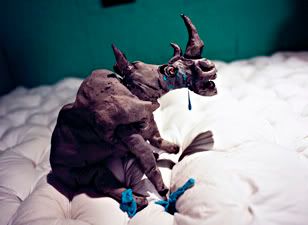
It's the Mother
Nathalie Djurberg’s ongoing exhibition at the Hammer Museum is one that is strangely dissonant. The very nature of her medium – short claymation films filled with bright, candied colors and cartoon-like figures – evokes impressions of child-friendly productions in the vein of Wallace & Gromit and Gumby. In fact, the three clips in this exhibition begin in such a fashion: innocent, easy on the eyes, and without a hint of anything portentous to come. However, these illusions are quickly pushed aside as each work quickly progresses into a portrait of the grotesque and macabre, oft through a strange, dream-like process. Djurberg is definitely no stranger to the expression of the primal, and motifs of pregnancy, lust and fear make their appearances throughout the exhibition. She also focuses a great deal on the interactions between children and parents in two of her works, while in her third work, adult figures seem to disappear completely. This seeming obsession with primitivism, childhood, and parent-child bonds hints of a Freudian aspect to her work. As such, examining her work through the lens of Psychoanalysis might serve to give us more insight into what lies behind it.
In It’s the Mother, a mother plays with a group of her children: all girls save one boy. The children are hyperactive and harangue their tired and worn-out mother to no end. One child approaches the mother’s genitals – perhaps hinting at the genital phase of Freudian psychosexual development – and starts to worm her way into her vaginal orifice, in a sort of “reverse birthing” process. The mother bloats up and is obviously in pain, but does nothing to stop her. The other children follow suit, one by one, in agonizing succession. Meanwhile the mother weeps, huge tears streaming down her body, while the remaining children comfort her and push down the protrusions that are beginning to form on her body. The boy goes in the last, but not after stroking her rather sensually. When all the children are inside, body parts start sprouting from the mother’s body and she metamorphosizes into a monstrous figure, struggling to maintain her balance.
This work is an intriguing play on parent-child relationships, and also an acknowledgement of the frightening, even insane things that children can be capable of. One is reminded of Freud’s belief that we are born with the “aggressive instinct”, which “already shows itself in the nursery” and reigned in primitive times. Even though the children show affection by comforting their mother, aggression seems to overcome their love as they still cause her pain in the end by re-entering her womb. Furthermore, the one son who is left seems to desire her sexually, hinting at some Oedipal attraction buried under the guise of comfort. In the end, we see that the mother has resigned herself to an unhappy fate just for her children; she is the one who suffers most from the parent-child bond. This just serves to illustrate the powerlessness of the mother figure in a patriarchical society, and the degree of her sacrifice for the sake of her children.

The Rhino and the Whale
Another work, The Rhino and the Whale, reiterates the primal theme of Djurberg’s first work in full force. In it, a grotesquely bloated pregnant woman totters around, clapping and whispering “Hello, hello”. Her actions pay off as a rhinoceros starts to emerge from her vagina. Once the rhinoceros is out, it cries while she comforts it. The woman then begins to move about the room, and the weeping rhinoceros tries to follow. She seems to want to get away from it, but he bites her buttocks to keep her in one place, so she resigns herself to her fate and pets it with her foot. An equally bloated man then appears and goes through the same ritualistic movements as the woman did. This time, a baboon appears from his anus and tries to jump onto the woman, chasing her away. It then lies down with the rhinoceros and finally both look content with each other.
The issues represented here are very similar to those in the first work, but there is a twist: in addition to the central female figure, there is a male character who functions as a kind of “mirror”, or foil, to her. Again, the issue of childhood longing of the son after the mother comes up, and this time the man’s situation provides a stark contrast. The man and woman go through the same “birth” process, but are treated very differently by their offspring. While the rhinoceros desires to be closer to his “mother”, the baboon deliberately pushes off from his “father”; the narrative has subtly taken an Oedipal turn. The motif of the mother being a powerless and sacrificial figure also returns, as the woman is unable to escape from the rhinoceros and has to tend to its needs.
As one can see, Djurberg’s works are filled with hints of Freudian elements. She unabashedly shows scenes of children being dismembered and eaten, or of a woman in the throes of giving birth, all in unsettlingly graphic detail. Nothing is repressed from the audience; Djurberg’s artistic process is a desublimation of sorts. While this may have been frowned upon by Freud himself, by no means does this imply that we cannot analyze her works using the ways that he pioneered.
Sources
Freud, Sigmund. Civilization and Its Discontents. New York: Norton & Company, Inc., 1961.
Foster, Hal, Krauss, Rosalind, Bois, Yve-Alain, and Buchloh, Benjamin H.D. Art Since 1900. New York: Thames and Hudson, 2007.

No comments:
Post a Comment